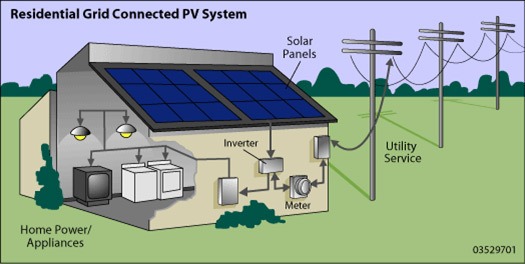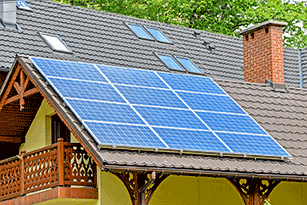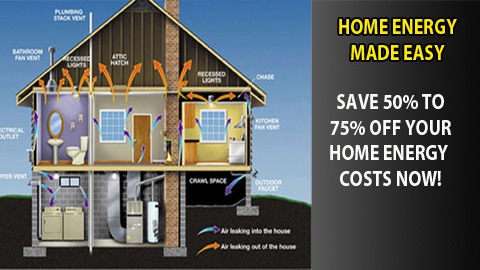
“Achieve the greatest volume and highest quality of produce possible, while reducing operating costs, and maximizing your profitability by growing smart.”
Tom Blount

Passive Solar Design
The most important thing to take away from this lesson is… You can easily design a passive solar system rather than pay $1000’s of dollars for a professional to do it.
This week’s lesson is intended to give you an in-depth look at various solar systems you can install, and which one is right for you.

Benefits of passive solar design
Components of a System
Interconnected solar cells, which convert sunlight directly into electricity, form a solar panel or “module,” and several modules connected together electrically form an array. Most people picture a solar electric system assimply the solar array, but a complete system consists of several other components.
- An inverter converts the direct current (DC) electricity produced by the modules into alternating current (AC) electricity for powering lights, appliances, and other needs.
- Wiring connects the various components of a solar electric system. In some cases, the system is also interconnected to the utility power grid. If the system produces more power than is required for the house, the utility may offer the homeowner credit for the excess power produced through a program called “net metering” or “net billing.” Your state energy office or local utility can provide more information.
- Batteries are used to store solar-produced electricity for nighttime or emergency backup power. Batteries may be required in locations that have limited access to power lines, as in some remote or rural areas.
- If batteries are part of the system, a charge controller is included to protect them from being overcharged or drawn down too low.
- Finally, disconnect switches allow the power from a solar electric system to be turned off to provide safety during maintenance or emergencies. Most providers of solar electric technologies can supply you with all the components you will need for a fully functional system.
Small Solar Electric Systems
A small solar electric or photovoltaic (PV) system can be a reliable and pollution-free producer of electricity for your home or office. And they're becoming more affordable all the time. Small PV systems also provide a cost-effective power supply in locations where it is expensive or impossible to send electricity through conventional power lines.
Because PV technologies use both direct and scattered sunlight to create electricity, the solar resource across the United States is ample for small solar electric systems. However, the amount of power generated by a solar system at a particular site depends on how much of the sun's energy reaches it. Thus, PV systems, like all solar technologies, function most efficiently in the southwestern United States, which receives the greatest amount of solar energy.
We are going to examine the following:
- How Small Solar Electric Systems Work Learn the basics of how a small PV system produces electricity.
- Considering a Small Solar Electric System: Start here to determine whether a small PV system would be feasible, practical, and economical for you.
- Small Solar Electric System Components: Learn more about system components—solar cells, modules, and balance-of-system parts.

How Small Solar Electric Systems Work
Solar electric systems, also known as photovoltaic (PV) systems, convert sunlight into electricity.
Solar cells—the basic building blocks of a PV system—consist of semiconductor materials. When sunlight is absorbed by these materials, the solar energy knocks electrons loose from their atoms. This phenomenon is called the "photoelectric effect."
These free electrons then travel into a circuit built into the solar cell to form electrical current. Only sunlight of certain wavelengths will work efficiently to create electricity. PV systems can still produce electricity on cloudy days, but not as much as on a sunny day.
The basic PV or solar cell typically produces only a small amount of power. To produce more power, solar cells (about 40) can be interconnected to form panels or modules. PV modules range in output from 10 to 300 watts. If more power is needed, several modules can be installed on a building or at ground-level in a rack to form a PV array.
PV arrays can be mounted at a fixed angle facing south, or they can be mounted on a tracking device that follows the sun, allowing them to capture the most sunlight over the course of a day.
Because of their modularity, PV systems can be designed to meet any electrical requirement, no matter how large or how small. You also can connect them to an electric distribution system (grid-connected), or they can stand alone (off-grid).
Considering a Small Solar Electric System
To help evaluate whether a small solar electric system will work for you, you should consider the following:
- Your available solar resource—do you have clear and unobstructed access to sunlight for most or all of the day, throughout the year?
- The system size—do you have a roof or area large enough to accommodate it?
- The economics—is it worth the investment?
- Local permits and covenants—are there any issues with installing a system?
Let’s look at each of these aspects in detail.
Evaluating Your Site's Solar Resource for Solar Electricity
The solar resource across the U.S. is ample for solar electric systems—also known as photovoltaic (PV) systems—because they can use both direct and scattered sunlight. However, the amount of electricity generated at a particular site depends on how much of the sun's energy reaches it. Thus, PV systems function most efficiently in the southwestern United States, which receives the greatest amount of solar energy.
Before you buy a PV system, you'll want to be sure your site has enough solar energy to meet your electricity needs efficiently and economically. Your local system supplier can perform a solar site analysis for you or show you how to do so on your own.
When evaluating your site, you'll also need to consider both the geographic orientation and the tilt of your solar panels—PV modules—as both can affect your system's performance.

Siting Your Small Solar Electric System
Both the orientation and tilt of your solar panels or photovoltaic (PV) modules will affect the output of your solar electric system. You and your contractor should consider both factors while evaluating your site's solar resource and sizing your system.
Orientation
PV modules should be oriented geographically to maximize the amount of daily and seasonal solar energy that they receive. In general, the optimum orientation for a PV module in the northern hemisphere is true south. However, your modules can face up to 45º east or west of true south without significantly decreasing its performance.
If you plan to mount the modules on your roof, you'll also want to consider these factors:
- Roof orientation and condition
- Local landscape features that shade the collector daily or seasonally
- Local weather conditions (foggy mornings or cloudy afternoons) that may affect the optimal orientation and subsequent electricity production of the PV modules.
To be eligible for some rebates, your system must be unshaded between certain hours during certain times of the year. Some states also have laws that establish your right to protect your solar access through the creation of a solar easement.
If a rooftop can't be used, your solar modules can also be placed on the ground, either on a fixed mount or a "tracking" mount that follows the sun to orient the PV modules.
Tilt
Most PV modules are mounted flat on the roof, and so have the same tilt as the roof. Although the optimal tilt angle for your modules is an angle equal to your latitude, fixing the PV modules flat on an angled roof is generally not a problem. However, because most roofs are pitched at an angle less than the latitude, you and your contractor will need to factor your roof angle into the performance calculations when sizing your system.
Sizing Your Small Solar Electric System
Accurately sizing the components of your solar electric system, also known as a photovoltaic (PV) system, helps ensure that your system will produce the amount of power you want it to produce. This is especially important for stand-alone systems, which are not connected to the electricity grid. However, because PV is modular, you can always add to your solar energy collector should you need more power down the road.
First, consider what portion of your current electricity needs you would like your PV system to meet. For example, suppose that you would like to meet a certain percentage of your electricity needs with your PV system. You could work with your PV provider to examine past electric bills and determine the size of the PV system needed to achieve that goal. You can contact your utility company and request the total electricity usage, measured in kilowatt-hours (kWh), for your household or business over the past 12 months or consult your electric bills if you save them.
If you reduce your electricity loads, you can generally buy a smaller, less expensive PV system.
In addition to how much electricity you'd like to generate, the size of your system also depends on these factors:
- The site's solar resource or available sunlight
- The system's orientation and tilt
- The system's efficiency at converting sunlight to electricity
- Other electricity sources, like a utility, a wind turbine, or a fossil fuel generator.
PV systems are classified by their rated power output (the peak power they produce when exposed to solar radiation of 1000 watts per square meter at a module temperature of 25°C). Systems rated between 1 and 5 kilowatts are generally sufficient to meet most of the needs of home and small business owners.
The table below provides an estimate of the roof area needed for several systems. Your system supplier/installer can make, or help you make, more precise calculations at your site before you purchase a system.
For example, to generate 2,000 watts from a 12%-efficient system, you need 200 square feet of roof area.

The Economics of a Small Solar Electric System
The economics of a small solar electric or photovoltaic (PV) system are determined by both the capital and operating costs. Capital costs include the initial costs of designing and installing a PV system. Operating costs include the costs associated with maintaining and operating the PV system over its useful life.
The factors that affect both capital and operating costs include:
- System components
Small Solar Electric System Components
A typical small solar electric, or photovoltaic (PV), system consists of these components:
- Solar cells
- Modules or panels (which consist of solar cells)
- Arrays (which consist of modules)
- Balance-of-system parts
- System size
- Whether a system is grid-connected or stands alone (off-grid)
- Solar resource at your location (amount of sunlight).
- Mounting racks and hardware for the panels
- Wiring for electrical connections
- Power conditioning equipment, such as an inverter
- Batteries for electricity storage (optional).
- Stand-by gasoline electric generator.
A typical small solar electric system usually includes the following balance-of-system components:
Electricity Consumption
Before selecting system components and sizing a PV system for an existing home, you should evaluate your energy consumption patterns and try to reduce your home's electricity use. You can start by performing a load analysis, which includes these tasks:
- Looking at your utility bills over the past year
- Calculating energy consumption
- Recognizing consumption trends.
By understanding your "energy habits" and becoming more energy efficient, you can reduce the size of the PV system you'll need, lowering both your capital and operating costs.

PV Cost Considerations
Ask your PV provider how much electricity your new PV system will produce per year (measured in kilowatt-hours) and compare that number to your annual electricity usage (called demand) to get an idea of how much you will save. As a rule, the cost per kilowatt-hour goes down as you increase the size of the system.
You should also compare the purchase price of utility-generated electricity to the higher costs of smaller PV systems. PV-generated electricity is usually more expensive than conventional, utility-supplied electricity. However, these costs will vary by geographic location.
Solar rebate programs, subsidies, and other incentives can help make PV more affordable. Tax incentives may include a sales tax exemption on the PV system purchase, a property tax exemption, or state personal income tax credits, all of which provide an economic benefit to consumers by lowering high capital costs.
Some solar rebate programs are capped at a certain dollar amount. Therefore, a solar electric system that matches this cap maximizes the benefit of the solar rebate.
Many homeowners use PV systems because other considerations—such as environmental benefits and energy independence—tip the balance in their favor.
Small Solar Electric System Permits and Covenants
Before purchasing a small solar electric system, you should research your local permit and neighborhood covenant requirements.
Local Permits
You will probably need to obtain permits from your city or county building department. These include a building permit, an electrical permit, or both. Typically, your photovoltaic (PV) provider will take care of this, rolling the price of the permits into the overall system price. However, in some cases, your PV provider may not know how much time or money will be involved in obtaining a permit.
If so, this task may be priced on a time-and-materials basis, particularly if additional drawings or calculations must be provided to the permitting agency. In any case, make sure the permitting costs and responsibilities are addressed at the start with your PV provider before installation begins.
Code requirements for PV systems vary somewhat from one jurisdiction to the next, but most are based on the National Electrical Code (NEC). Article 690 in the NEC spells out requirements for designing and installing safe, reliable, code-compliant PV systems.
If you are one of the first people in your community to install a PV system, your local building department may not have experience in approving one of these systems. If this is the case, you and your PV provider can speed up the process by working closely with building officials to educate them on the technology.
Neighborhood Covenants
If you live where a homeowners association must approve a solar electric system, you or your PV provider will likely need to submit your plans and get approval before you begin installing your PV system. However, some state laws stipulate that you have the right to install a solar electric system on your home.

